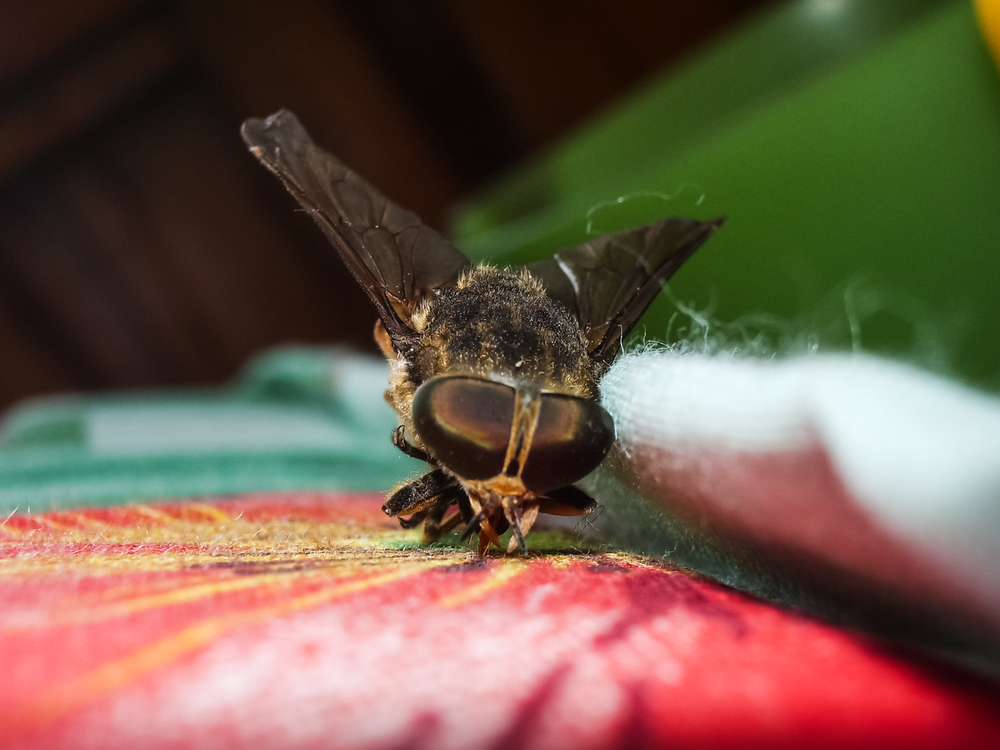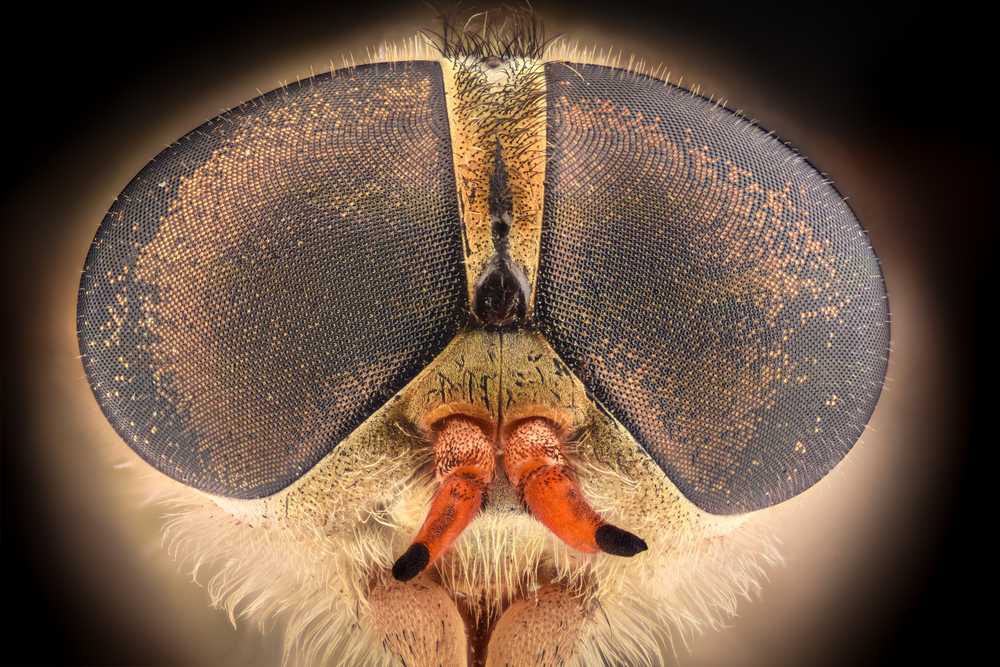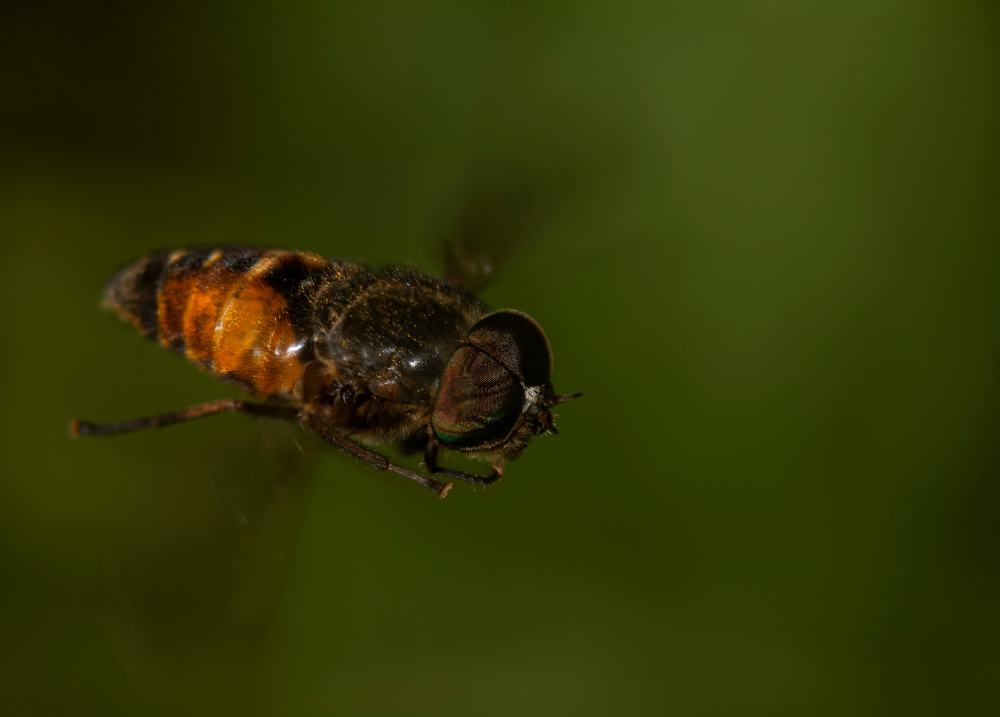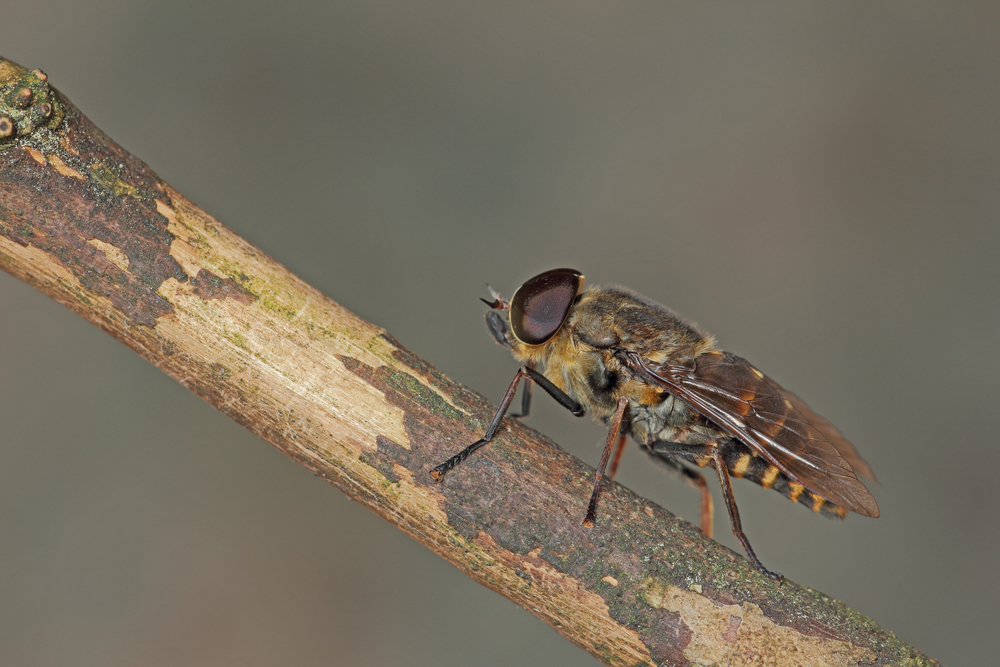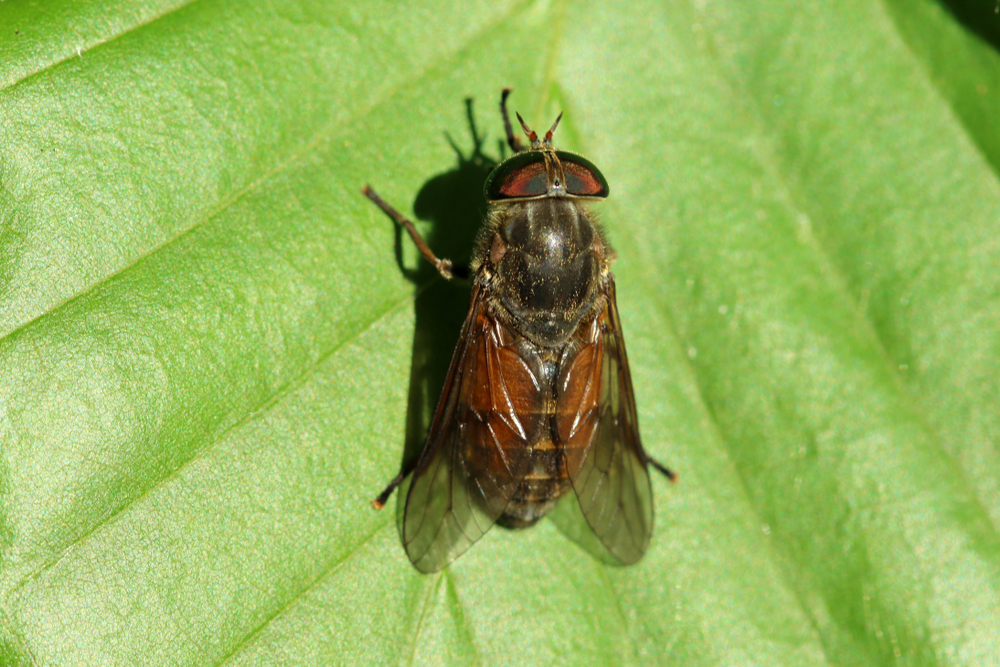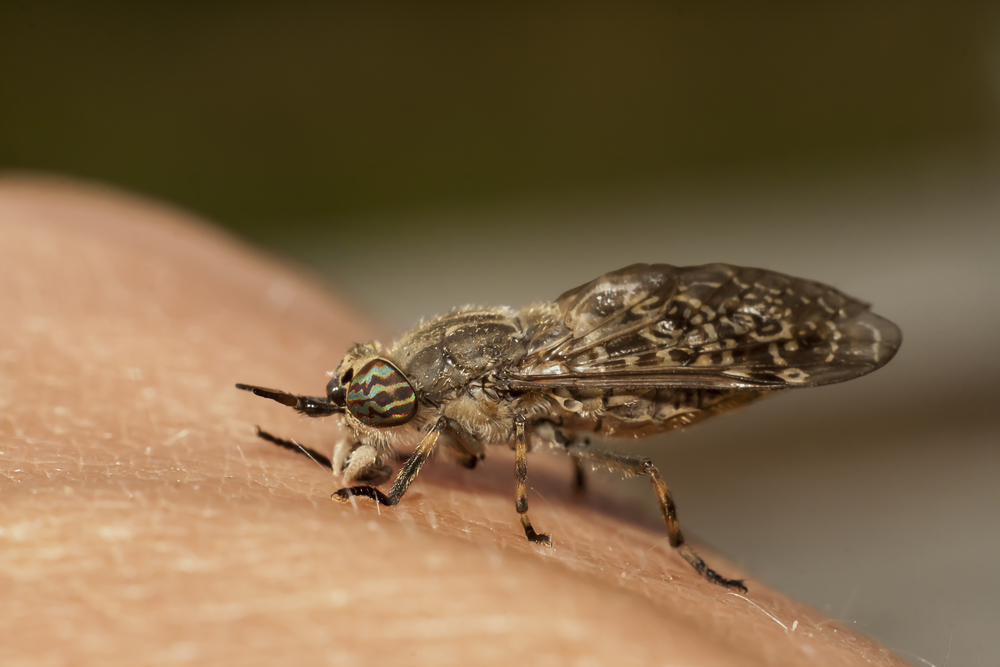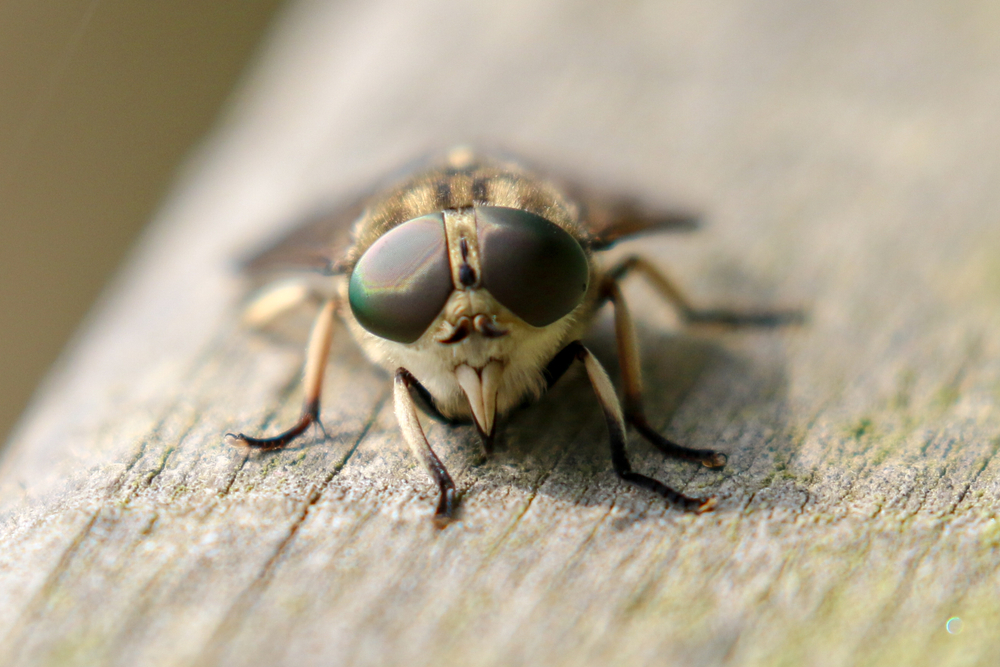About
The Horse Fly, scientifically known as Tabanidae, belongs to the Animal Kingdom’s phylum Arthropoda and class Insecta. It is a member of the Tabanidae family, which also includes other biting fly species like deer flies and clegs. Horse flies are widely distributed across the globe, inhabiting various habitats from forests to grasslands.
These insects are known for their robust bodies, large eyes, and stout mouthparts adapted for piercing and sucking blood. They are primarily active during the daytime and are notorious for their painful bites, which can be irritating to livestock and humans alike. Female horse flies require blood meals for egg production, while males typically feed on nectar and plant juices.
Horse flies play ecological roles as both pollinators and pests. While their bites can be bothersome, they also contribute to pollination by feeding on flower nectar. However, their blood-feeding behavior can transmit diseases to animals, making them significant vectors for pathogens such as equine infectious anemia and tularemia.
Conservation Concerns
Horse flies themselves are not subject to conservation assessments or listed on the IUCN Red List. However, their presence and population dynamics are closely tied to the health of ecosystems and the species they interact with. Changes in land use, habitat degradation, and climate change can impact horse fly populations and their interactions with hosts.
Efforts to conserve biodiversity and maintain healthy ecosystems can indirectly benefit horse flies by preserving their habitats and reducing human-wildlife conflicts. Additionally, integrated pest management strategies may help manage horse fly populations in areas where they pose significant threats to livestock and human health. Continuous monitoring of insect populations and research on their ecological roles are essential for understanding and mitigating potential impacts on ecosystems.
Physical Characteristics
The horsefly is a common name for a number of species of flies in the family Tabanidae. These insects are known for their biting and bloodsucking behavior in females, who require blood to produce eggs. Horse flies vary widely in size and appearance, but here are general physical characteristics common to many species within this group:
Size
- Body Length: Horse flies range in size from about 0.4 inches to 1.25 inches (1 to 3 centimeters) in length, with some of the largest species reaching lengths of more than 1.25 inches (3 centimeters).
- Weight: While specific weights for horse flies are not typically noted due to their small size, they are extremely lightweight, certainly less than a few grams.
Physical Characteristics
- Color: Horse fly coloration can vary widely depending on the species. They often have dark bodies, but can also exhibit a range of colors including brown, black, or even iridescent greens and blues. Their bodies are sometimes covered in hair.
- Head: Horse flies have large, prominent eyes that are often brightly colored or iridescent. These compound eyes provide them with excellent vision for locating hosts. The space between the eyes differs by gender; it is wider in females and narrower in males.
- Mouthparts: Females possess specially adapted mouthparts capable of cutting through skin to feed on blood. These mouthparts look like a set of serrated blades and are highly effective at piercing skin. Males, in contrast, feed on nectar and have mouthparts not suited for bloodsucking.
- Wings: Their wings are usually clear or slightly cloudy but can have darker markings. The wing shape and venation (the pattern of veins on the wings) are often used to identify different species of horseflies.
- Legs: Horse flies have sturdy legs, with the hind legs being longer than the front and middle legs. The legs can have a variety of colors and sometimes are banded or patterned.
Horse flies are considered pests to both humans and animals, especially in rural and agricultural areas, because of their painful bites and potential to transmit diseases to livestock. Their physical characteristics, especially their efficient mouthparts and strong flight capabilities, make them highly adapted to their parasitic lifestyle.
Reproduction
The reproductive cycle of the horse fly, a member of the Tabanidae family, is an intriguing process influenced by environmental factors and seasonal changes. Here’s an overview:
Breeding Season: Horse flies typically breed during the warmer months when environmental conditions are favorable for egg development and larval growth. The exact timing of the breeding season can vary depending on the species and geographical location.
Mating Behavior: Male horse flies employ various strategies to locate and mate with females. They often utilize visual cues and pheromones to identify receptive females and engage in aerial pursuit to mate successfully.
Courtship and Copulation: Courtship rituals in horse flies may involve elaborate displays or physical interactions between males and females. Once a male successfully courts a female, copulation occurs, typically lasting for a brief period.
Egg Laying: After mating, female horse flies seek suitable oviposition sites to lay their eggs. These sites are often near water sources or areas with suitable substrates for larval development, such as moist soil or decaying organic matter.
Egg Development and Hatching: Horse fly eggs undergo development over a relatively short period, typically hatching within a few days to a couple of weeks, depending on environmental conditions. The larvae, known as maggots, emerge from the eggs and begin their development.
Larval Development: Horse fly larvae are aquatic or semi-aquatic, depending on the species, and undergo several developmental stages known as instars. They feed voraciously on organic matter, including decaying vegetation and other organic debris, as they grow and mature.
Pupation: Once larvae reach their final instar stage, they typically leave the water or substrate and seek a suitable location for pupation. The pupal stage is a crucial period of transformation, during which the larva undergoes metamorphosis to become an adult horse fly.
Adult Emergence: After completing the pupal stage, adult horse flies emerge from their pupal cases and take to the air. They begin actively seeking mates and food sources, continuing the reproductive cycle to ensure the next generation of horse flies.
Life Cycle Dynamics and Population Control: The reproductive cycle of horse flies plays a vital role in population dynamics and ecosystem interactions. Understanding these processes is essential for implementing effective control measures to manage horse fly populations and minimize their impact on humans and livestock.
Lifespan
Horse flies are large, robust flies belonging to the family Tabanidae, known for their painful bites and affinity for livestock, including horses. Here’s an overview of their lifespan and the threats they face:
Lifespan in the Wild: In the wild, the lifespan of a horse fly varies depending on factors such as species, environmental conditions, and availability of food sources. Generally, adult horse flies live for several weeks to a few months. However, their developmental stages, including egg, larva, and pupa, can last from several weeks to months, depending on environmental conditions.
Lifespan in Captivity: There is limited information on the lifespan of horse flies in captivity as they are primarily pests and not typically kept in controlled environments. However, under optimal conditions with access to suitable food sources and environmental conditions similar to their natural habitat, horse flies may live for similar durations as in the wild.
Threats to the Horse Fly:
- Predators: Horse flies face predation from various natural enemies, including birds, bats, spiders, and other insects. Predators play a role in regulating horse fly populations, although their impact may vary depending on local ecosystems and environmental conditions.
- Parasitism: Horse flies may also fall victim to parasitoid wasps and other parasitic organisms that lay their eggs on or inside the horse fly larvae or pupae. These parasitoids develop at the expense of horse flies, reducing their populations in the wild.
- Habitat Loss: Habitat loss and degradation due to human activities, such as agriculture, urbanization, and deforestation, can impact horse fly populations by reducing suitable breeding sites and food sources. Loss of wetland habitats, in particular, can affect species of horse flies that require aquatic or semi-aquatic environments for breeding.
- Pesticides and Chemicals: Horse flies may be exposed to pesticides and other chemical pollutants used in agriculture, livestock farming, and pest control. These chemicals can directly impact horse fly populations by causing mortality or indirectly by disrupting their reproductive behaviors and developmental processes.
- Climate Change: Climate change can affect horse fly populations by altering temperature and precipitation patterns, leading to changes in their distribution, abundance, and seasonal activity. Warmer temperatures and increased rainfall may favor the proliferation of some horse fly species, while extreme weather events can disrupt their life cycle and breeding habitats.
- Livestock Management Practices: Livestock management practices, such as poor sanitation, overcrowding, and inadequate pest control measures, can create favorable conditions for horse fly populations to thrive. Infestations of horse flies can cause stress, discomfort, and reduced productivity in livestock, leading to economic losses for farmers.
Addressing threats to horse fly populations requires integrated pest management strategies, habitat conservation measures, and sustainable agricultural practices aimed at minimizing human impacts on natural ecosystems. By understanding the biology and ecology of horse flies and implementing effective control measures, it is possible to mitigate their negative effects on livestock and ecosystems.
Eating Habits
The horse fly, belonging to the family Tabanidae, is a common insect known for its biting behavior. Understanding its eating habits provides insight into its role as a blood-feeding insect and its interactions with other organisms. Let’s explore the feeding habits of the horse fly.
Diet: Horse flies are hematophagous insects, meaning they feed on the blood of mammals, including horses, cattle, humans, and other animals. Their diet primarily consists of blood, which provides essential nutrients required for egg development in females.
Feeding Behavior: Horse flies exhibit specific feeding behaviors to obtain blood:
- Biting: Female horse flies are the primary blood feeders, using their specialized mouthparts to pierce the skin of their hosts and extract blood. They have stout, bayonet-like mouthparts known as proboscis, which they use to lacerate the skin and feed on the blood that pools at the bite site.
- Host Seeking: Horse flies are attracted to their hosts by visual cues such as movement, color, and body heat. They are known to be persistent pests, often circling around potential hosts until they find an opportunity to land and feed.
- Mechanism of Feeding: Once a horse fly lands on its host, it uses its sharp mouthparts to create a wound in the skin. It then secretes anticoagulants and enzymes into the wound to prevent blood clotting and facilitate the flow of blood. The horse fly feeds until it is engorged with blood, after which it will leave the host to digest its meal and potentially seek another host.
Ecological Impact:
- While horse flies play a role in ecosystems as pollinators and food sources for other organisms, their biting behavior can have negative impacts on livestock and humans. In addition to causing pain and discomfort, horse fly bites can transmit diseases and result in secondary infections.
- In areas where horse flies are abundant, livestock may experience reduced productivity and suffer from stress-related conditions due to constant harassment by these pests.
Control Measures:
- Various control methods are employed to manage horse fly populations and minimize their impact on humans and livestock. These may include the use of insecticides, repellents, traps, and habitat modifications to reduce breeding sites.
- Integrated pest management strategies that combine multiple control measures are often the most effective approach for controlling horsefly populations while minimizing environmental impact and non-target effects.
Uniqueness
The Horse Fly, belonging to the family Tabanidae, is a common sight worldwide, particularly in rural and near-water environments. Known for their bothersome bites, horse flies are distinct from other flies in several key ways. Here are some aspects that make the Horse Fly unique:
Size and Appearance: Horse flies are larger than many other flies, typically measuring between 1 to 2.5 cm in length. They have stout bodies and large, often colorful and iridescent eyes which give them excellent vision. Their wings are usually clear or slightly cloudy but can have darker patterns.
Painful Bites: One of the most notable features of horse flies is their biting behavior. Female horse flies need to consume blood to reproduce effectively, and their mouthparts are specially adapted for this purpose. Unlike mosquitoes, which pierce the skin with a proboscis, horse flies have mandibles that can slice or rip the skin to access blood, making their bites particularly painful.
Feeding and Reproduction: Only female horse flies feed on blood, which they require to mature their eggs. Males, on the other hand, typically feed on nectar and do not bite. The females are attracted to movement, warmth, carbon dioxide, and dark objects, which often leads them to feed on livestock, wildlife, and humans.
Breeding Habits: Horse fly larvae are aquatic or semi-aquatic, often found in marshy or wet areas. Females lay their eggs on vegetation close to water, and the larvae drop into the water or wet soil upon hatching. The larvae are predatory, feeding on other insects, which they continue to do until they pupate and emerge as adult flies.
Impact on Animals and Humans: Horse flies are a significant nuisance to livestock. Their bites not only cause pain but can also transmit diseases and reduce livestock productivity by causing animals to expend energy fending off flies instead of feeding or resting.
Ecological Role: Despite their negative aspects, horse flies play important ecological roles. The larvae help control other insect populations, and the adults are pollinators for some types of flowers.
Adaptability: Horse flies are found in diverse environments across the globe, from dense forests to open farmlands and even arctic regions. Their ability to thrive in various climates shows their adaptability and resilience.
Challenges in Control: Due to their fast flight and tendency to disperse widely, horse flies are challenging to control. Repellents that work on mosquitoes and other insects are often less effective on horse flies, complicating efforts to manage their populations.
Horse flies, with their painful bites and significant role in both ecosystems and agriculture, are a uniquely challenging insect. Their lifecycle, from predatory larvae to blood-feeding adult females, highlights their complexity and the difficulties in mitigating their impact on humans and animals.




































































